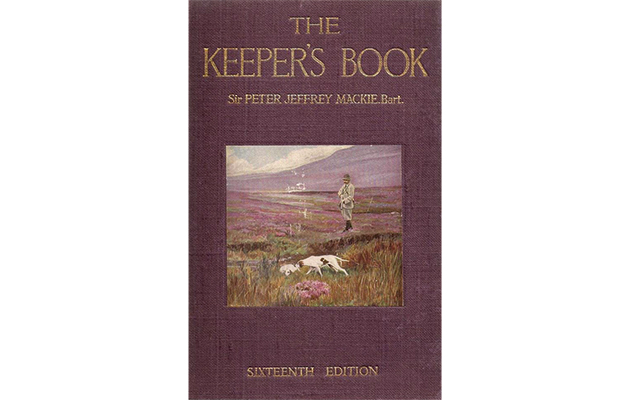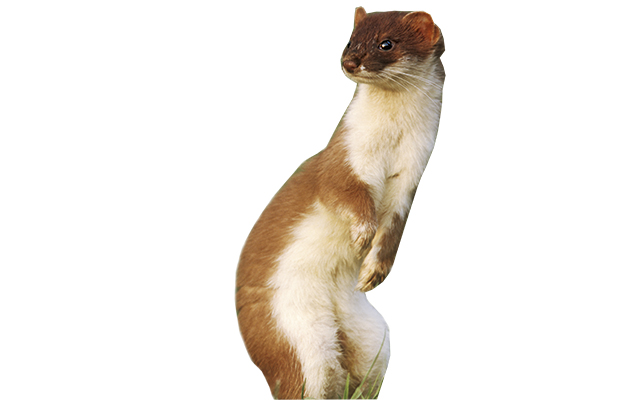They may be the villains of Wind in the Willows, but stoats and weasels deserve respect for their resilience and courage, says Daniel Allen
Stoats and weasels have an undeserved, bad reputation. From the weasels that plot to take over Toad Hall in Wind in the Willows to being accused of killing sleeping infants, they were creatures to fear. But despite such adversity stoats and weasels have survived and for this, as Daniel Allen says, we must respect them.
For more on animals, read Christmas animals: bestiary of a feast day, and learn about the creatures that we both love and fear in our festive tales and traditions.
STOATS AND WEASELS
Mustelids generally have a murderous reputation. That of otters as fish-killers immediately comes to mind. Stoats and weasels have always been described in bloodthirsty, even vampirical terms, their ability to kill affording them near-supernatural powers.
In 1801, for example, The Cabinet; Or the Natural History of Quadrupeds, Birds, Fishes and Insects (published anonymously) maintained that a stoat “kills both the rein-deer and the bear”. How, you may wonder. “It jumps into one of these animal’s ears, and adheres so fast that it cannot be disengaged.” There were tales that
children were not safe in their own homes from stoats and weasels. Richard Jefferies, author of The Gamekeeper at Home (1906), wrote, “Labouring people – at least the elder folk – declare that they have been known to suck the blood of infants left asleep in the cradle upon the floor, biting the child behind the ear.”
If this were not enough to strike fear into rural communities, anecdotes of people being attacked by packs of stoats often appeared in natural history publications. In History of Mammals (1854) naturalist the Reverend JG Wood recounted a story of a gentleman stumbling upon two stoats during a walk. On his pathway, the man threw a stone, striking one stoat, which let out a loud cry, answered by many other stoats in the hedges. They then “sprang upon their assailant, running up his body with surprising rapidity and striving to reach his neck”. Four miles later, “His hands, face and part of his neck were covered with wounds.” His good fortune, according to Wood, was in knowing the killing tactic of the species: “owing to the presence of mind with which he had defended his neck, the large blood-vessels had escaped without injury.”
With their smaller, slender frames, one would assume that weasels would not be such a menace to society. A common myth, for instance, was that they could pass through a man’s wedding ring. Size did not prevent reports of pack attacks, however. According to James Hamilton Fennell, author of Natural History of British and Foreign Quadrupeds (1843), a Dumfriesshire man “was suddenly attacked by six weasels, which rushed upon him from an old dike in the field”, in January 1818. Alarmed, he ran, only to be pursued. When “they were about to seize him by the neck”, he “snatched up the branch of a fallen tree” and killed three of them; the rest fled.
As they were rarely seen in the wild, aside from on the gamekeeper’s gibbet, such knowledge was widely accepted. With this in mind, it seems Kenneth Grahame’s literary representations of the “Wild Wood” residents and stoats and weasels in The Wind in the Willows (1908) were relatively accurate, dare I say, tame: “A band of weasels, armed to the teeth, crept silently up the carriage-drive to the front entrance. Simultaneously, a band of desperate ferrets, advancing through the kitchen garden, possessed themselves of the back-yard and offices; while a company of skirmishing stoats who stuck at nothing occupied the conservatory and the billiard room.”
There is no doubt that behaviours of stoats and weasels have informed folkloric tales and literary representations. In return, this has normalised their status as vermin. The degree of exaggeration, however, does come into question. What are the ecological realities of these species? How do they differ? What
functions do they actually play in the countryside? To understand this, we must take their reputation by the throat, strip away the rural rhetoric, and consider the factual bones of contention.
STOATS AND WEASELS: THEIR ROLE IN THE COUNTRYSIDE
One certainty is that stoats and weasels, as carnivores are highly adept predators, specialised in small mammals and birds. They are relentless in pursuit of prey and ruthless in the act of killing. The sworn enemy that stoats and weasels share is the gamekeeper. The rise of sporting estates and growing popularity of shooting in the 19th century led to an increase in the number of gamekeepers: from 15,000 in 1871 to more than 23,000 in 1911 (Potts, 1986, cited by King 1989). Unsurprisingly, the total of predators killed rose and pine martens, polecats and raptors disappeared. Stoats and weasels did not.
Stoats are renowned for being generalist predators and highly damaging for shooting estates. “He is a merciless tyrant, a meaningless murderer, shedding blood from mere wantonness. Both ground and winged game fall victims to his blood thirstiness. Even wood-pigeons are not exempt from his rapacity,” asserted Sir Peter Jeffrey Mackie in The Keeper’s Book, A guide to the duties of a gamekeeper (1929). Yet, as generalists, stoats and weasels also act as pest controllers, preying on hares, rabbits, rats, mice and voles. This earned them a degree of respect. In Diary of a Hunter (1981) David Brian Plummer admitted, “I like stoats, they represent all that is vital, alive and quicksilver to me, but they have to go, I’m afraid. The land is going to be used to house some poultry chicks.”
Biology is also on the stoats’ side. More specifically, sex. Where female stoats have delayed implantation, male stoats fertilise their own unweaned offspring and the mother after the birth. With litters of up to 13 kits, this
unsavoury family affair ensures kits will be produced the following spring. Stoat kits learn to hunt with their mother at around one month, and can hunt and kill for themselves by three months. This stage of development accounts for the misconception that all stoats hunt in packs (Hart-Davis, 2002; King, 1989). The fur of the stoat is also important. Why? The much-celebrated ermine is, in fact, the persecuted stoat. They are the same animal. Ermine is the name for its white winter coat. This may not have influenced gamekeepers, but eradicating a valuable, albeit small, fur source would have been questionable.
STOATS AND WEASELS: THE WEASEL’S BIG REPUTATION
The weasels is the stoat’s smaller cousin and despite being the smallest carnivorous mammal in Britain, it has a big reputation. Dr Carolyn King cited the “instinctive hatred of weasels” of a Forties gamekeeper in The Natural History of Weasels and Stoats (2006): ‘There is something decidedly sinister about their looks; something serpentine that makes us shudder… Weasels look like killers, and many of us get a self-righteous feeling when we shoot one.” Their elongated appearance is perfectly adapted for hunting in burrows; mice, voles, shrews and leverets top their list of prey, accompanied by rabbits, small birds and eggs.
Much like the stoat’s, the weasel’s instinct to overkill and cache food was seen as wasteful bloodlust. As weasels require roughly a third of their bodyweight in food each day, this is certainly instinctive killing. Yet, interestingly, some suggest weasels may have been partly persecuted due to mistaken identity. In Silent Fields (2007) Roger Lovegrove notes, “Weasels were probably blamed for some damage that should be more accurately attributed to stoats.” Those with a vested interest in agriculture also valued the weasel’s eating habits. Sir Harry Johnston (1903) maintained that “the farmer who would slay them… would indeed be a crass fool; for the weasel will wind its way out of the burrows made by mice, and almost, if not entirely, rid the rick of these pests”. More broadly, through his knowledge of rabbiting, professional warrener Bob Smithson (1992) made a case for the value of “foxes, stoats and weasels” stating, “While the rabbit bears the brunt of the predatory offensive other animals and birds receive the benefit.”
STOATS AND WEASELS: GOING VIRAL

Stoats have been observed dancing hypnotically in front of their prey so as to lure them within striking distance.
In March 2015 the opportunistic ways of the weasel became an international story when amateur photographer Martin Le-May shared his photograph of a weasel “riding” a green woodpecker. “Weasel Woodpecker” as it would be known became a worldwide viral sensation. The unique shot deserved the plaudits but many overlooked that it was an unsuccessful attempt at predation. “Initially I did not realise the woodpecker was being attacked… The woodpecker (with the weasel still attached) landed in front of us and I feared the worst. But I guess our presence momentarily distracted the weasel, as the woodpecker seized the opportunity and flew up and away into some bushes and out of sight,” Le-May reflected. Bizarrely, this incident could be described as the best public relations episode the weasel has ever had.
Just days later (8 March) another weasel appeared in the tabloid press. “Guess who wins: Desperate weasel tries to fight off hungry heron”, was the Mail Online headline. Birdwatcher Jonathan Forgham had photographed a weasel attacking a heron at Elmley Nature Reserve on the Isle of Sheppey off Kent. A bite on the beak led the heron to pick up the weasel and fly to a nearby pond.
“I drove the car round there in time to see the heron try to drown the weasel. It lifted it out of the water and then dunked it again to make sure it was dead,” Forgham said. “When the weasel was quite motionless the heron swallowed it. Afterwards it didn’t do much. It just stood there looking quite smug.” A further fascinating glimpse into the tenacious nature of the weasel and its own vulnerability to predation. Foxes, cats, owls and raptors are more commonly associated with predation on weasels.
Whether gamekeepers could not or would not eliminate stoats and weasels is debatable. Either way, despite centuries of misconceptions and persecution, stoats and weasels remain relatively common in the UK. The latest
estimates from the Game and Wildlife Conservation Trust suggest a population of 462,000 stoats and 450,000 weasels. Such resilience, such survival against adversity demands respect and appreciation of the
vital role these species have had – and continue to have – in the ecological balance of the whole countryside.
Dr Daniel Allen is a Fellow of the Royal Geographical Society and Teaching Fellow at Keele University.













